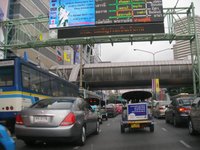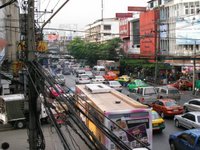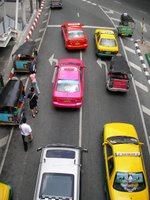
I guess every large city has its own particular traffic problems and unique features, but in Central Bangkok the traffic seems to dominate one's experience. From the various interesting vehicle types to the complex junctions with their technical-looking roadsigns,

from the noise and the fumes to the ever-present chance that – even walking through a crowded street market – you could be nudged out of the way by a family, baby and all, on a motor scooter: you can't ignore the traffic.

For the tourist there are several ways to get around: there's apparently a metro system, although I never saw any evidence of it. There are buses, but I don't know if tourists ever use them – we didn't. We did, however, use the Skytrain – a modern monorail system that, while efficient and good value for money, disappoints due to poor coverage - there are only two lines and they seem pretty short. I may be doing it an injustice because we only used it once and I didn't research it thoroughly, but the fact that the hotel lays on a free shuttle service to the nearest station tells you that it's not the most comprehensive mass transit system.
The two most commonly used forms of transport are the taxi and it's cheekier, smaller brother, the tuk-tuk.
Tuk-tuks are motorized three-wheelers with a roof; kind of a modern-day rikshaw. The driver sits up front and has motorcycle-style handlebars and car-style pedals, and the single bench seat in the back can take three adults quite comfortably, although I did see a couple of tuk-tuks laden with four and even five people. The taxis themselves are regular saloon cars, but what's striking about them is the variety of colours available. Very bright, day-glo reds, pinks, purples, greens and yellows make taxis hard to miss.


The hotel warns you not to use either taxis or tuk-tuks on the basis that the drivers' motives are less than honourable, but we didn't have much choice if we wanted to get around town so we chanced it with the taxis, drawing the line at tuk-tuks.

The main thing to know when using a Bangkok taxi is to ignore the sign on the roof saying, “TAXI-METER”, because very few of them actually bother using their meters. What you need to do is tell them where you want to go and negotiate a fixed price for the journey before you get in, otherwise you'll get a nasty shock at journey's end when the drivers tries to overcharge you. This is actually a good thing, since even short journeys can take half an hour or more due to the congestion, and a metered trip could work out quite expensive.
 Roads near the King's Palace were brightly decorated with royal tributes; the Thais really love their royal family. Note the sticky tape holding the windscreen together!
Roads near the King's Palace were brightly decorated with royal tributes; the Thais really love their royal family. Note the sticky tape holding the windscreen together!The other thing you need to remember is, once you've told the driver where you want to go, stick to it and don't let him talk you into going somewhere else, which he will try to do. We fell for that trick on our first night, which I'll tell you about in the next posting.





No comments:
Post a Comment